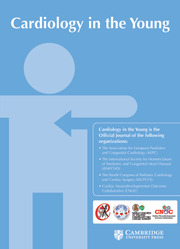No CrossRef data available.
Article contents
Developmental language trajectories in children with critical CHD
Published online by Cambridge University Press: 26 March 2025
Abstract
Medical and surgical advancements have enabled a 95% survival rate for children with CHD. However, these survivors are disproportionately affected by neurodevelopmental disabilities. In particular, they have behavioural problems in toddlerhood. Because there is a known relationship between behavioural problems and early language delay, we hypothesise that children with critical CHD have early detectable language deficits. To test our hypothesis, we performed a retrospective study on a cohort of children with critical CHD to visualise their early language developmental trajectories.
We identified a cohort of 27 children with two diagnoses: single ventricle physiology (19) and transposition of the great arteries (8). As part of their routine clinical care, all of these children had serial developmental evaluations with the language subsection of the Capute Scales. We visualised their developmental language trajectories as a function of chronologic age, and we used a univariate linear regression model to calculate diagnosis-specific expected developmental age equivalents.
In each group, language development is age-appropriate in infancy. Deviation from age-appropriate development is apparent by 18 months. This results in borderline-mild language delay by 30 months.
Using the Capute Scales, our team quantified early language development in infants and toddlers with critical CHD. Our identification of deceleration in skill acquisition reinforces the call for ongoing neurodevelopmental surveillance in these children. Understanding early language development will help clinicians provide informed anticipatory guidance to families of children with critical CHD.
Children with single ventricle physiology and transposition of the great arteries have measurable early language delays.
- Type
- Original Article
- Information
- Copyright
- © The Author(s), 2025. Published by Cambridge University Press



